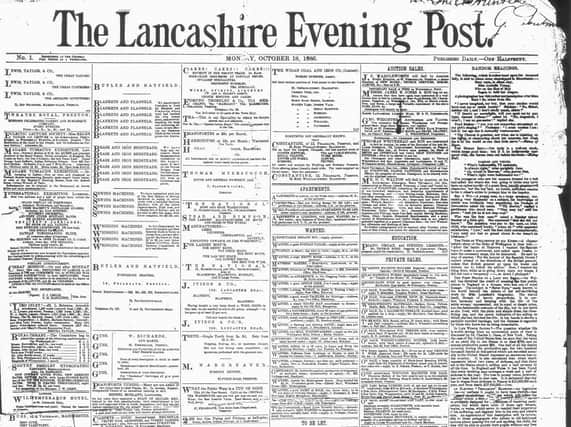Happy 130th birthday Lancashire Evening Post


The Lancashire Evening Post remains Preston’s leading newspaper after a lifetime that has seen many a local newspaper fall by the wayside.In fact, as long ago as 1740 the first newspaper appeared on Preston’s streets. The Preston Journal only had a short existence with big news stories of the day likely to have been of the Jacobite Rebellion and the fleeting visits of Charles Edward Stuart the Young Pretender. Between the late 18th century and the middle of the 19th century a host of newspapers came and went including the Preston Review, Preston Sentinel, Preston Pilot, Preston Observer, Preston Advertiser and Preston Guardian and serious competition arrived. In 1855 Stamp Duty on newspapers was abolished and the price of a daily or weekly read dropped considerably. Consequently other newspapers arrived on the scene to tempt those who could read included the Preston Mercury, Preston Telegraph, The Wasp, The Echo and the Preston Herald. The latter became like the Preston Chronicle, by then owned by Anthony Hewitson, and the Preston Guardian, bought by George Toulmin in 1859, a twice-weekly publication. With the population of the town rising to upwards of 55,000 they all attempted to establish daily publications but without success.In 1870 George Toulmin made a serious bid for the daily market with the introduction of the Preston Evening News, but this paper faltered also after a few months. Undeterred, George Toulmin and Sons gave it another go in 1886 when they published for the first time the Lancashire Evening Post. The new daily paper was designed to appeal to a far reaching and diverse readership and it was successful. The first edition appeared on Tuesday October 18 consisting of four pages and costing one half penny. The front page was devoted to advertising with errand boys and domestic servants in demand, tea and cakes for sale and piano lessons on offer. The headline news inside the paper included a fire at Hawkins Mill, in Adelphi Street, a murder in Belgium and a report from the Lancaster Quarter Sessions. There was news and features from Lytham, Blackpool, Blackburn, Darwen, Bacup and Haslingden as the paper planned to extend their net wide for readers. By the Saturday, in the 7pm edition, there was a report of Preston North End’s match away to Wolverhampton Wanders that afternoon, which they won by 5-1, thus beginning a long tradition of local football reporting which continues to this day.The popularity of a daily newspaper caught on and the Lancashire Evening Post thrived with a circulation far beyond the boundaries of Preston by the time George Toulmin died in 1888 leaving his sons in control of the business. In 1893 the paper changed its name to the Lancashire Daily Post, a title it took into the next century before eventually reverting back to its original name. Back in 1876 the newspaper had made the headlines when Blackburn child killer William Fish had used back copies to wrap up the remains of his unfortunate victim. The gruesome find being made by Preston’s famous bloodhound Morgan which had been loaned to the Chief Constable of Blackburn to track the killer down. Great advances in the production of newspapers followed with manual power, steam engine power, gas power and finally electricity all being used to ensure an ever increasing circulation was created for. From its pioneering days the LEP was produced on a combined web printing and folding machine designed by Joseph Foster’s the Preston based company. Mind you, a crew of 40 compositors were necessary in setting the type and preparing it for printing.There was barely a break in production down the years save the odd public holiday or the events of May 1926 when a few days production were lost due to the General Strike which crippled the country and type written sheets were issued from the Post HQ.Traditionally the front page of the Post, like many a newspaper, was reserved exclusively for advertisements until the out break of the Second World War that is. The first Monday of September 1939 having a ground breaking headline story about the liner Athenia being torpedoed.Generations of the Toulmin family served the LEP for decades including George Fisher Toulmin, a grandson of the founder, who spent 39 years managing affairs before his retirement in 1946 when the paper had a readership of more than 50,000.By this time the 1960s newspapers were being printed at the Lancashire Evening Post headquarters in Fishergate where town centre shoppers could purchase copies hot off the presses with latest racing results and football or cricket scores in the late news column. On a Saturday evening shortly before 6pm a queue would form to obtain a copy of the ‘Last Football’ essential reading for the sports fans of Preston. In 1989 there was much interest when the Lancashire Evening Post moved from their familiar Fishergate location to a green field site at Fulwood. The then owners United Newspapers investing £28m in the latest locally built Goss printing presses and a press hall and office block to suit on Oliver’s Place. With the advances in printing technology it was the dawn of the colourful newspapers of today.In later years the LEP became part of the Johnston Press group and the printing side of the business, after mergers and takeovers, was from 2001 part of the Northern & Shell Group under the banner of Broughton Printers. Despite the closure of Broughton Printers in 2015 the newspaper still flourishes and although printed further afield it maintains its strong Preston links, the editorial staff essential for its production are located just a short distance from the familiar Oliver’s Place site on Caxton Road. After 130 years of daily printing that’s more than 40,000 editions and counting of the city’s most popular paper.